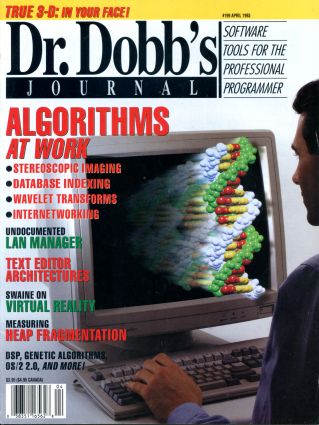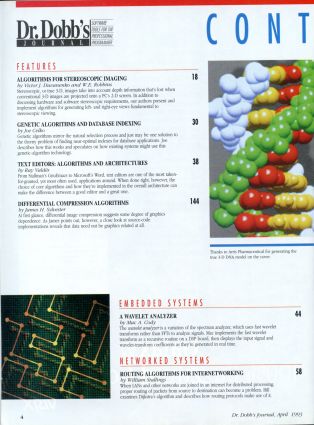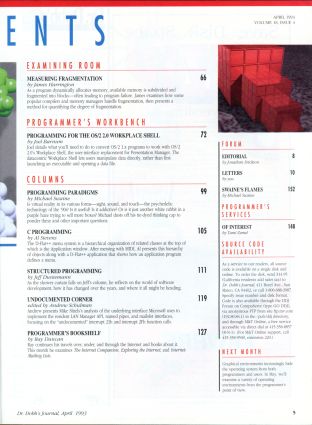
p.8 EDITORIAL
[author : Jonathan Erickson] #Edito
TABLE OF CONTENTS
FEATURES
p.18 ALGORITHMS FOR STEREOSCOPIC IMAGING
[author : Victor J. Duvanenko and W. E. Robbins]
Stereoscopic, or true 3-D, images take into account depth information that's lost when conventional 3-D images are projected onto a PC's 2-D screen. In addition to discussing hardware and software stereoscopic requirements, our authors present and implement algorithms for generating left- and right-eye views fundamental to stereoscopic viewing.
p.30 GENETIC ALGORITHMS AND DATABASE INDEXING
[author : Joe Celko]
Genetic algorithms mirror the natural selection process and just may be one solution to the thorny problem of finding near-optimal indexes for database applications. Joe describes how this works and speculates on how existing systems might use this genetic-algorithm technology.
p.38 TEXT EDITORS: ALGORITHMS AND ARCHITECTURES
[author : Ray Valdes]
From Stallman's GnuEmacs to Microsoft's Word, text editors are one of the most taken-for-granted, yet most often used, applications around. When done right, however, the choice of core algorithms and how they're implemented in the overall architecture can make the difference between a good editor and a great one.
p.144 DIFFERENTIAL COMPRESSION ALGORITHMS
[author : James H. Sylvester]
At first glance, differential image compression suggests some degree of graphics dependence. As James points out, however, a close look at source-code implementations reveals that data need not be graphics related at all.
EMBEDDED SYSTEMS
p.44 A WAVELET ANALYZER
[author : Mac A. Cody]
The wavelet analyzer is a variation of the spectrum analyzer, which uses fast wavelet transforms rather than FFTs to analyze signals. Mac implements the fast wavelet transform as a recursive routine on a DSP board, then displays the input signal and wavelet-transform coefficients as they're generated in real time.
NETWORKED SYSTEMS
p.58 ROUTING ALGORITHMS FOR INTERNETWORKING
[author : William Stallings]
When LANs and other networks are joined in an internet for distributed processing, proper routing of packets from source to destination can become a problem. Bill examines Dijkstra's algorithm and describes how routing protocols make use of it.
EXAMINING ROOM
p.66 MEASURING FRAGMENTATION
[author : James Harrington]
As a program dynamically allocates memory, available memory is subdivided and fragmented into blocks - often leading to program failure. James examines how some popular compilers and memory managers handle fragmentation, then presents a method for quantifying the degree of fragmentation.
PROGRAMMER'S WORKBENCH
p.72 PROGRAMMING FOR THE OS/2 2.0 WORKPLACE SHELL
[author : Joel Barnum]
Joel details what you'll need to do to convert OS/2 1.x programs to work with OS/2 2.0's Workplace Shell, the user-interface replacement for Presentation Manager. The datacentric Workplace Shell lets users manipulate data directly, rather than first launching an executable and opening a data file.
COLUMNS
p.99 PROGRAMMING PARADIGMS
[author : Michael Swaine]
Is virtual reality in its various forms — sight, sound, and touch — the psychedelic technology of the 90's? Is it useful? Is it addictive? Or is it just another white rabbit in a purple haze trying to sell more boxes? Michael dusts off his tie-dyed thinking cap to ponder these and other important questions.
p.105 C PROGRAMMING
[author : Al Stevens]
The D-Flat++ menu system is a hierarchical organization of related classes at the top of which is the Application window. After messing with MIDI, Al presents this hierarchy of objects along with a D-Flatt++ application that shows how an application program defines a menu.
p.111 STRUCTURED PROGRAMMING
[author : Jeff Duntemann]
As the shower curtain falls on Jeff's column, he reflects on the world of software development, how it has changed over the years, and where it all might be heading.
p.119 UNDOCUMENTED CORNER
[author : Andrew Schulman]
Andrew presents Mike Shiels's analysis of the underlying interface Microsoft uses to implement the resident LAN Manager API, named pipes, and mailslot interfaces, focusing on the "undocumented" interrupt 21h and interrupt 2Fh function calls.
p.127 PROGRAMMER'S BOOKSHELF
[author : Ray Duncan]
Ray continues his travels over, under, and through the Internet and books about it. This month he examines The Internet Companion, Exploring the Internet, and Internet: Mailing Lists.
FORUM
p.10 LETTERS
[author : you]
p.152 SWAINE'S FLAMES
[author : Michael Swaine]
PROGRAMMER'S SERVICES
p.148 OF INTEREST
[author : Tami Zemel]

